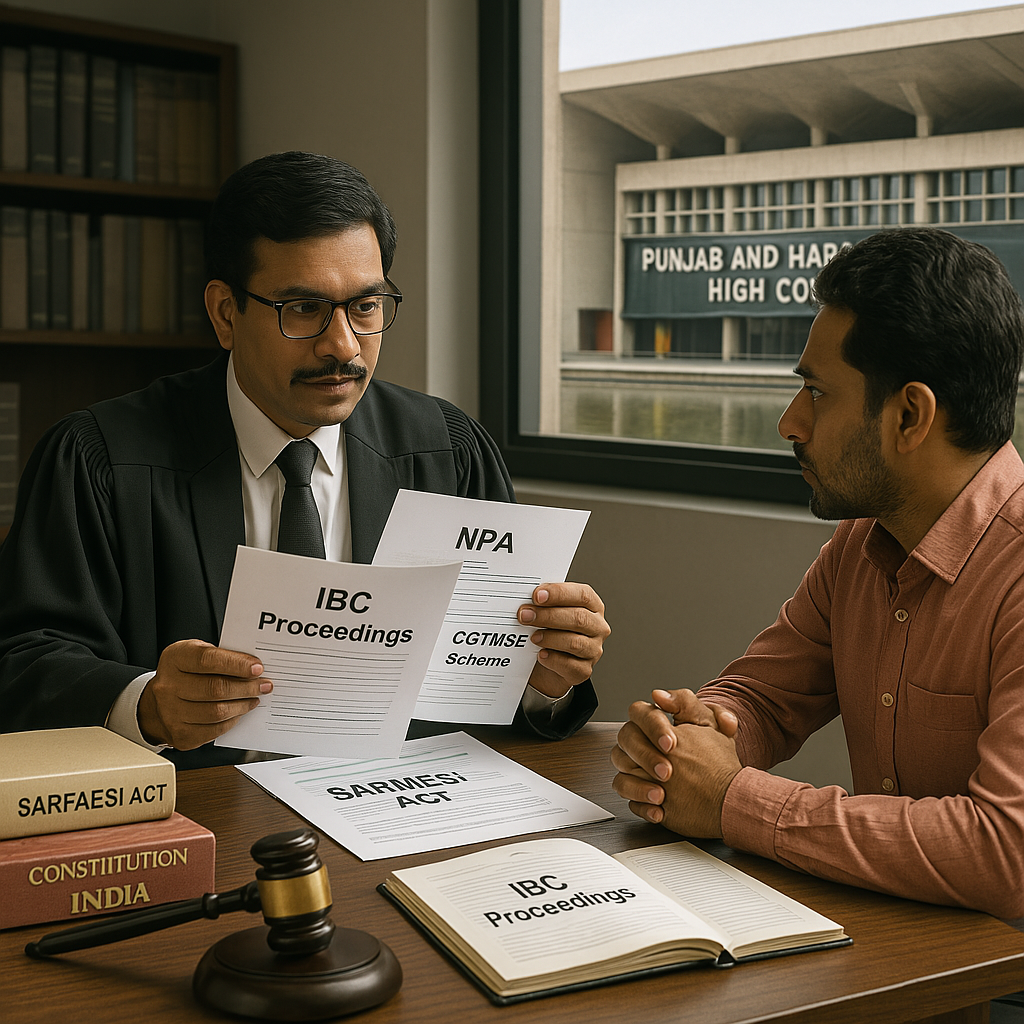With the rising number of non-performing asset (NPA) cases and increasing defaults triggered by financial distress, particularly post-COVID-19, several small and medium enterprises (SMEs) have found themselves entangled in debt recovery proceedings initiated by banks under the SARFAESI Act, 2002. In some cases, borrowers allege that banks engage in wrongful NPA classification under the SARFAESI Act, despite having grounds to retain a standard or substandard asset classification. This article explores key legal remedies available to borrowers and guarantors when such wrongful actions are taken by banks, especially when no collateral in the form of immovable property was secured, and the borrower is financially incapable of repayment.
Understanding the Legal Classification of NPAs Under RBI Guidelines
As per RBI’s Master Circular on Prudential Norms on Income Recognition and Asset Classification, an account is declared as NPA only when interest or principal remains overdue for more than 90 days. A substandard asset is defined as an asset that has remained an NPA for a period of less than or equal to 12 months.
In the landmark case of Swiss Ribbons Pvt. Ltd. v. Union of India [(2019) 4 SCC 17], the Supreme Court reiterated that banks must strictly follow the 90-day overdue rule before classifying any loan account as an NPA. Any deviation from this, including pre-emptive NPA declaration before the end of the statutory 90-day period, would be contrary to RBI norms and liable to be challenged.
Violation of Section 13(3A) of the SARFAESI Act
Under Section 13(2) of the SARFAESI Act, secured creditors are required to issue a demand notice for the repayment of dues. Section 13(3A) mandates that if the borrower makes a representation or objection to such notice, the bank must consider it and communicate its decision with reasons before proceeding further.
In Swapnil Hosiery & Textile Manufacturing Company Pvt. Ltd. v. United Bank of India [2017 SCC OnLine DRT 24], the Debt Recovery Tribunal set aside a possession notice issued under Section 13(4) because the bank failed to comply with the statutory duty under Section 13(3A). This reaffirms that borrowers have a valuable statutory right to be heard before coercive action is taken by financial institutions.
No Collateral Security? The Role of CGTMSE Scheme
Many micro and small enterprises in India avail loans under government-backed schemes such as CGTMSE (Credit Guarantee Fund Trust for Micro and Small Enterprises), where banks provide collateral-free loans. In such cases, borrowers may argue that banks willingly undertook the risk of lending without securing immovable property, hence they cannot arbitrarily enforce SARFAESI measures where such collateral does not exist.
The CGTMSE scheme aims to extend financial assistance to first-time borrowers by reducing the requirement for security, and lenders are backed by government guarantees. Borrowers can raise a legal point that loan accounts under such schemes must be evaluated differently in SARFAESI proceedings, especially in cases of financial duress caused by uncontrollable events like the COVID-19 pandemic.
When Borrowers and Guarantors Have No Means to Repay: Resorting to Insolvency under IBC, 2016
Where borrowers and guarantors are genuinely incapable of repayment, one of the most viable options is to invoke the Insolvency and Bankruptcy Code (IBC), 2016. This can be initiated by the borrower itself as a Corporate Debtor, leading to:
- Appointment of a Resolution Professional (RP)
- Possibility of debt restructuring or revival
- Failing which, liquidation of assets
The advantage of IBC lies in its moratorium provisions under Section 14, which stay all existing legal proceedings, including those under SARFAESI or DRT, during the Corporate Insolvency Resolution Process (CIRP).
Jurisdictional Challenge: DRT vs. NCLT
If the borrower is a corporate entity and intends to proceed under IBC, it can challenge the jurisdiction of the Debt Recovery Tribunal (DRT), which is empowered primarily to adjudicate SARFAESI and recovery matters. Insolvency proceedings, however, fall within the domain of the National Company Law Tribunal (NCLT).
Thus, a well-structured argument can be made that DRT lacks the authority to deal with insolvency issues, and recovery proceedings must be stayed in light of pending or proposed IBC action.
Strategic Legal Defences for Borrowers
- Challenge Wrongful NPA Classification: File a detailed reply citing RBI circulars and Supreme Court precedents like Swiss Ribbons.
- Raise Section 13(3A) Violations: Argue that the bank failed to consider representations before issuing SARFAESI measures.
- Invoke CGTMSE Loan Structure: Highlight that no immovable property was pledged, and the loan was granted under a government guarantee.
- Initiate IBC Proceedings: Use insolvency law to restructure debt or liquidate assets, if revival is not possible.
- File Writ Petition, if Needed: If there’s procedural non-compliance or violation of natural justice, approach the High Court under Article 226.
In cases where banks act hastily or unjustly by classifying a loan account as an NPA—especially when no immovable collateral was taken, and financial hardship is well-documented—borrowers have strong legal grounds to contest the action. With proper documentation, invocation of statutory rights under SARFAESI, and use of IBC as a protective shield, financially distressed enterprises can seek structured remedies and avoid harsh recovery measures.
Legal guidance from experienced DRT advocates, IBC professionals, and High Court lawyers in Chandigarh or other jurisdictions is essential for framing a solid defense and safeguarding the rights of borrowers.
FAQs on Wrongful NPA classification under SARFAESI Act
1. Can I challenge the bank’s decision to classify my loan account as NPA before 90 days?
Answer: Yes. As per RBI guidelines and judgments like Swiss Ribbons v. Union of India, a loan account can only be declared an NPA after 90 days of non-payment. If your account was classified prematurely, experienced lawyers in Chandigarh can help file a legal challenge before the Debt Recovery Tribunal (DRT) or High Court, citing violations of prudential norms.
2. What are my legal rights under Section 13(3A) of the SARFAESI Act?
Answer: Under Section 13(3A), borrowers have a statutory right to respond to the bank’s demand notice, and the bank must consider and reply to that representation. If it fails to do so, advocates in Chandigarh can argue that further SARFAESI action is invalid and seek relief from the DRT or through writ jurisdiction.
3. Does SARFAESI apply when there is no immovable property as collateral?
Answer: If your loan was sanctioned under schemes like CGTMSE without any immovable collateral, SARFAESI may not be fully enforceable. DRT lawyers in Chandigarh can raise this point as a defence, highlighting that the bank knowingly accepted the lending risk and should not invoke SARFAESI inappropriately.
4. What is the role of IBC if the borrower has no means to repay?
Answer: When both the borrower and guarantor are financially incapable of repaying, IBC (Insolvency and Bankruptcy Code) provides a structured remedy. IBC advocates in Chandigarh can help initiate insolvency proceedings to either restructure debt or proceed to liquidation, offering legal protection from aggressive recovery actions.
5. Can Debt Recovery Tribunal (DRT) hear insolvency matters?
Answer: No. DRT has jurisdiction over debt recovery and SARFAESI enforcement. Insolvency matters fall under the National Company Law Tribunal (NCLT). High Court lawyers in Chandigarh can challenge DRT’s jurisdiction if insolvency proceedings are initiated or planned.
6. How can I stop the bank from taking possession of my business assets?
Answer: If SARFAESI action is based on procedural irregularities—such as premature NPA classification or lack of response under Section 13(3A)—advocates in Chandigarh can file for a stay on proceedings before DRT or seek an injunction through a writ petition in the High Court.
7. Can CGTMSE loans be recovered through SARFAESI?
Answer: CGTMSE loans are collateral-free and backed by government guarantee. In such cases, SARFAESI applicability is limited. Bank dispute lawyers in Chandigarh often argue that the bank should invoke CGTMSE claims instead of targeting the borrower through coercive recovery measures.
8. What documents should I collect to contest a SARFAESI notice?
Answer: You should gather the loan sanction letter, repayment records, scheme documents (like CGTMSE), RBI circulars, and a copy of the notice issued under Section 13(2). Experienced DRT advocates in Chandigarh can use these to prepare a detailed representation and build your defence.

